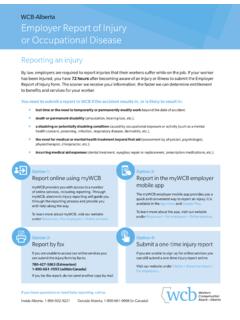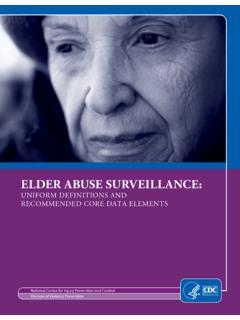Transcription of Workplace Violence in Healthcare - Occupational Safety and ...
1 CARING FOR OUR CAREGIVERS CARING FOR OUR CAREGIVERS Workplace Violence in HealthcareUnderstanding the Challenge Workplace Violence is a serious problem. Different organizations have defined Workplace Violence in various ways. The National Institute for Occupational Safety and Health defines Workplace Violence as violent acts, including physical assaults and threats of assault, directed toward persons at work or on duty. Enforcement activities typically focus on physical assaults or threats that result or can result in serious physical harm. However, many people who study this issue and the Workplace prevention programs highlighted here include verbal Violence threats, verbal abuse, hostility, harassment, and the like which can cause significant psycho-logical trauma and stress, even if no physical injury takes place. Verbal assaults can also escalate to physical hospitals, nursing homes, and other Healthcare settings, possible sources of Violence include patients, visitors, intruders, and even coworkers.
2 Examples include verbal threats or physical attacks by patients, a distraught family member who may be abusive or even become an active shooter, gang Violence in the emergency depart-ment, a domestic dispute that spills over into the Workplace , or coworker bullying. Healthcare workers are at an increased risk for Workplace Violence . From 2002 to 2013, incidents of serious Workplace Violence (those requiring days off for the injured worker to recuperate) were four times more common in Healthcare than in private industry on average. In 2013, the broad Healthcare and social assistance sector had cases of serious Workplace Violence per 10,000 full-time employees (see graph below). Other large sectors such as construction, manufacturing, and retail all had fewer than two cases per 10,000 full-time employees. Violent Injuries Resulting in Days Away from Work, by Industry, 2002 2013 Workplace Violence risk factors vary by Healthcare setting, but common factors include the following.
3 1 Working with people who havea history of Violence or whomay be delirious or under theinfluence of drugs Lifting, moving, andtransporting patients Working alone Poor environmental design thatmay block vision or escaperoutes Poor lighting in hallways orexterior areas Lack of means of emergencycommunication Presence of firearms Working in neighborhoods withhigh crime rates Lack of training and policies forstaff Understaffing in general, andespecially during meal timesand visiting hours High worker turnover Inadequate security staff Long wait times andovercrowded waiting rooms Unrestricted public access Perception that violenceis tolerated and reportingincidents will have no Department of (800) 321-OSHA (6742)OSHA 3826 - 12/20152 Violent incidents come from a variety of sources. Many are not are the largest source of Violence in Healthcare settings, but they are not the only source. In 2013, 80 percent of serious violent incidents reported in Healthcare settings were caused by interactions with patients (see graph).
4 Other incidents were caused by visitors, coworkers, or other people. Healthcare Worker Injuries Resulting in Days Away from Work, by SourceData source: Bureau of Labor Statistics (BLS), 2013 data. These data cover three broad industry sectors: ambulatory Healthcare services, hospitals, and nursing and residential care facilities. Source categories are defined by BLS. Violence is vastly underreported. The numbers above only include incidents that led to time away from work. While some data are available for other violent incidents, surveys show that many incidents go unreported, even at facilities with formal incident reporting For example, a survey of 4,738 Minne-sota nurses found that only 69 percent of physical assaults and 71 percent of non-physical assaults were reported to a manager,3 while one medical center found that half of verbal and physical assaults by patients against nurses were never reported in Bullying and other forms of verbal abuse are par-ticularly prone to underreporting.
5 Reasons for underreporting include lack of a reporting policy, lack of faith in the reporting system, and fear of retaliation. Placeholder PhotoAssailant/suspect/inmate1%Other client or customer12%Student3%Coworker3%Other person (not specified)1%Patient80%Unique challenges in Healthcare Healthcare has some unique cultural factors that may contribute to underreporting or acceptance of Workplace Violence . For example, caregivers feel a professional and ethical duty to do no harm to patients. Some will put their own Safety and health at risk to help a patient, and many in Healthcare professions consider Violence to be part of the job. Healthcare workers also recognize that many injuries caused by patients are unintentional, and are therefore likely to accept them as routine or unavoidable. Another consideration is unwillingness among Healthcare workers to stigmatize the perpetrators due to their illness or is also evolving in ways that increase the challenge.
6 For example, because of reduced funding for mental health services, severely ill patients with violent tendencies are increasingly using emergency departments rather than more specialized facilities for Violence is widespread in Healthcare highlight the prevalence of Workplace Violence among Healthcare occupations: 21 percent of registered nurses and nursing students reported being physically assaulted and over 50 percent ver-bally abused in a 12-month period (2014 American Nurses Association s Health Risk Appraisal survey of 3,765 registered nurses and nursing students).5 12 percent of emergency department nurses experienced physical Violence and 59 percent experienced verbal abuse during a seven-day period (2009 2011 Emergency Nurses Association survey of 7,169 nurses).6 13 percent of employees in Veterans Health Administration hospitals reported being assaulted in a year (2002 survey of 72,349 workers at 142 facilities).
7 7 Some professions and settings are more at risk than others. In 2013, according to the Bureau of Labor Statistics, psychiatric aides experienced the highest rate of violent injuries that resulted in days away from work, at approximately 590 injuries per 10,000 full-time employees. This rate is more than 10 times higher than the next group, nursing assistants, who experienced about 55 such injuries per 10,000 full-time employees. Registered nurses experienced about 14 violent injuries resulting in days away from work per 10,000 full-time employees, compared with a rate of in private industry as a whole. Surveys show that high-risk areas include emergency departments, geriatrics, and behavioral health, among ,7In 2013, the most common causes of violent injuries resulting in days away from work across several Healthcare occupations were hitting, kicking, beating, and/or shoving (see graph).Violent Injuries Resulting in Days Away from Work, by Cause01,0002,0003,0004,0005,0006,0007,00 08,000 Licensed practical andvocational nursesRegistered nursesNursing, psychiatric,and home health aidesData source: Bureau of Labor Statistics, 2013 of casesHitting, kicking, beating, shovingInjury by physical contact with person while moving that person unintentionalInjury by other person unintentional or intent unknown not elsewhere classifiedInjury by physical contact with person while restraining or subduing unintentionalIntentional injury by other person not elsewhere classified4 Workplace Violence is costly and Violence comes at a high cost.
8 If an employee requires medical treatment or misses work because of a Workplace injury , workers compensation insurance will typically have to pay the cost. For example, one hospital system had 30 nurses who required treatment for violent injuries in a particular year, at a total cost of $94,156 ($78,924 for treatment and $15,232 for lost wages).8 If your organization self-insures (as some large Healthcare organizations do), it will bear the full cost. If your organization does not, its claim experience can still affect insurance can also lead to other less obvious costs. For example: Caregiver fatigue, injury , and stress are tied to a higher risk of medication errors and patient Studies have found higher patient satisfaction levels in hospitals where fewer nurses are dissatisfied or burned Injuries and stress are common factors that drive some caregivers to leave the profession. The estimated cost of replacing a nurse is $27,000 to $103, This cost includes separation, recruiting, hiring, orientation, and training.
9 Some estimates also account for lost productivity while a replacement is hired and facilities can reduce Workplace Violence by following a comprehensive Workplace Violence prevention program. An effective program includes five key components: Management commitment and worker participation Worksite analysis and hazard identification Hazard prevention and control Safety and health training Recordkeeping and program evaluationA Workplace Violence prevention program can also fit effectively into a broader Safety and health management system, and it can help your facility enhance employee and patient Safety , improve the quality of patient care, and promote constructive labor-management Violence Prevention Resources OSHA s Guidelines for Preventing Workplace Violence for Healthcare and Social Service Workers describe the five components of an effective Workplace Violence prevention program, with extensive examples. See Preventing Workplace Violence : A Road Map for Healthcare Facilities expands on OSHA s guidelines by presenting case studies and successful strategies from a variety of Healthcare facilities.
10 See Workplace Violence Prevention and Related Goals: The Big Picture explains how you can achieve synergies between Workplace Violence prevention, broader Safety and health objectives, accreditation, and a culture of Safety . See Occupational Safety and Health Administration (OSHA). 2015. Guidelines for preventing Workplace Violence for Healthcare and social service workers. No. 3148-04R. 2 Findorff, , McGovern, , Wall, , and Gerberich, 2005. Reporting Violence to a health care employer: A cross-sectional study. AAOHN Journal. 53(9): 399 Gerberich, , Church, , McGovern, , Hansen, , Nachreiner, , Geisser, , Ryan, , Mongin, , and Watt, 2004. An epidemiological study of the magnitude and consequence of work related Violence : The Minnesota Nurses Study. Occupational and Environmental Medicine. 61(6):495 ASIS International. 2011. Managing Disruptive Behavior and Workplace Violence in American Nurses Association.

















